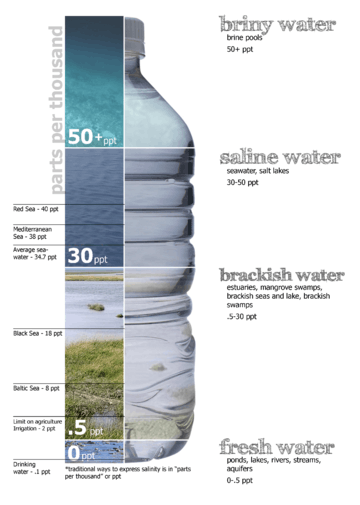Hypersaline lake
A hypersaline lake is a landlocked body of water that contains significant concentrations of sodium chloride or other salts, with saline levels surpassing that of ocean water (3.5%, i.e. 35 grams per litre or 0.29 pounds per US gallon).

| Part of a series on |
| Water salinity |
|---|
 |
| Salinity levels |
|
Fresh water (< 0.05%) Brackish water (0.05–3%) Saline water (3–5%) Brine (> 5% up to 26%-28% max) |
| Bodies of water |
Specific microbial and crustacean species thrive in these high-salinity environments[1] that are inhospitable to most lifeforms. Some of these species enter a dormant state when desiccated, and some species are thought to survive for over 250 million years.[2]
The water of hypersaline lakes has great buoyancy due to its high salt content.
Hypersaline lakes are found on every continent, especially in arid or semi-arid regions.[1]
In the Arctic, the Canadian Devon Ice Cap contains two subglacial lakes that are hypersaline.[3] In Antarctica, there are larger hypersaline water bodies, lakes in the McMurdo Dry Valleys such as Lake Vanda with salinity of over 35% (i.e. 10 times as salty as ocean water).
The most saline water body in the world is the Gaet'ale Pond, located in the Danakil Depression in Afar, Ethiopia. The water of Gaet'ale Pond has a salinity of 43%, making it the saltiest water body on Earth;[4] (i.e. 12 times as salty as ocean water). Previously, it was considered that the most saline lake outside of Antarctica were Lake Assal,[5] in Djibouti, which has a salinity of 34.8% (i.e. 10 times as salty as ocean water). Probably the best-known hypersaline lakes are the Dead Sea (34.2% salinity in 2010) and the Great Salt Lake in the state of Utah, USA (5–27% variable salinity). The Dead Sea, dividing Israel and the Palestinian West Bank from Jordan, is the world's deepest hypersaline lake, and the Araruama Lagoon in Brazil is the world's largest.[6] The Great Salt Lake, located in Utah, while having nearly three times the surface area of the Dead Sea, is shallower and experiences much greater fluctuations in salinity. At its lowest recorded water levels, it approaches 7.7 times the salinity of ocean water, but when its levels are high, its salinity drops to only slightly higher than that of the ocean.[7][8][9]
See also
- Brine pool – large area of brine on the ocean basin
- Halocline – Stratification of a body of water due to salinity differences
- Halophile – organism that thrives in high salt concentrations
- List of bodies of water by salinity
- Salt lake – one with a concentration of salts and minerals significantly higher than most lakes
References
- Hammer, Ulrich T. (1986). Saline lake ecosystems of the world. Springer. ISBN 90-6193-535-0.
- Vreeland, R.H.; Rosenzweig, W.D. & Powers, D.W. (2000). "Isolation of a 250 million-year-old halotolerant bacterium from a primary salt crystal". Nature. 407 (6806): 897–900. doi:10.1038/35038060. PMID 11057666.
- Muzyka, Kyle (11 April 2018). "Super salty lakes discovered in Canadian Arctic could provide window into life beyond Earth". CBC News. Retrieved 11 April 2018.
- Perez, Eduardo; Chebude, Yonas (April 2017). "Chemical Analysis of Gaet'ale, a Hypersaline Pond in Danakil Depression (Ethiopia): New Record for the Most Saline Water Body on Earth". Aquatic Geochemistry. 23 (2): 109–117. doi:10.1007/s10498-017-9312-z.
- Quinn, Joyce A.; Woodward, Susan L., eds. (2015). Earth's Landscape: An Encyclopedia of the World's Geographic Features [2 volumes]. ABC-CLIO. p. 9. ISBN 978-1-61069-446-9.
- Goetz, P.W., ed. (1986). The New Encyclopædia Britannica. 3 (15th ed.). p. 937.
- Wilkerson, Christine. "Utah's Great Salt Lake and Ancient Lake Bonneville, PI39 – Utah Geological Survey". Geology.utah.gov. Archived from the original on 2010-08-15. Retrieved 2010-08-03.
- Allred, Ashley; Baxter, Bonnie. "Microbial life in hypersaline environments". Science Education Resource Center at Carleton College. Retrieved 2010-06-17.
- Kjeldsen, K.U.; Loy, A.; Jakobsen, T.F.; Thomsen, T.R.; et al. (May 2007). "Diversity of sulfate-reducing bacteria from an extreme hypersaline sediment, Great Salt Lake (Utah)". FEMS Microbiol. Ecol. 60 (2): 287–298. doi:10.1111/j.1574-6941.2007.00288.x. PMID 17367515.